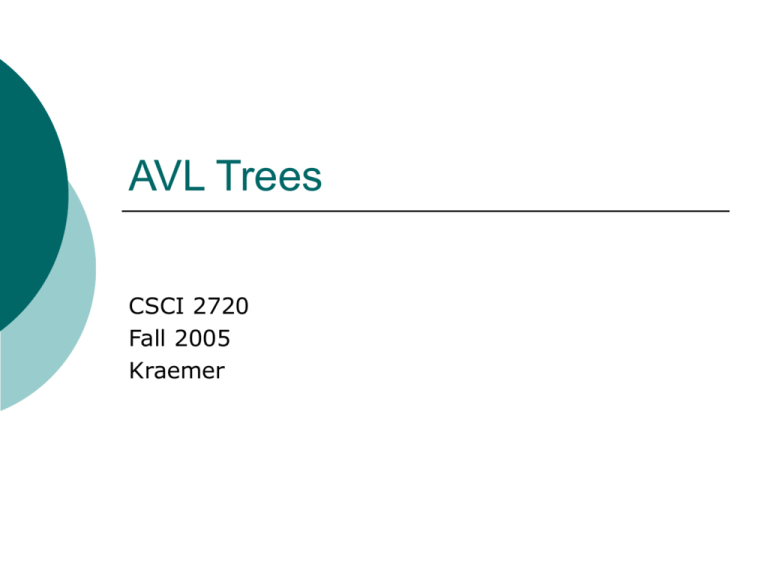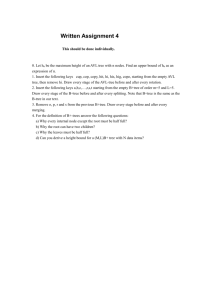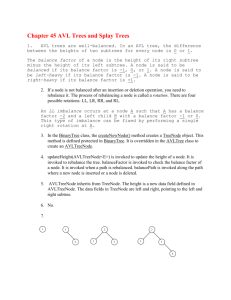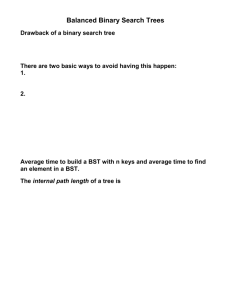Binary Trees
advertisement

AVL Trees
CSCI 2720
Fall 2005
Kraemer
Binary Tree Issue
One major problem with the binary trees
we have discussed thus far:
they can become extremely unbalanced
in the worst case scenario, inserts are done
in order
this will lead to long search times
this leads to a linked list structure
possible O(n) performance
this is not likely but it’s performance will tend to
be worse than O(log n)
Binary Tree Issue
BinaryTree tree = new BinaryTree();
tree.insert(A);
tree.insert(C);
tree.insert(F);
tree.insert(M);
A
tree.insert(Z);
root
C
F
M
Z
Balanced Tree
In a perfectly balanced tree
all leaves are at one level
each non-leaf node has two children
root
M
E
C
S
J
O
W
Worst case search time is log n
AVL Tree
AVL tree definition
a binary tree in which the maximum difference
in the height of any node’s right and left subtrees is 1 (called the balance factor)
balance factor = height(right) – height(left)
AVL trees are usually not perfectly
balanced
however, the biggest difference in any two
branch lengths will be no more than one level
AVL Tree
-1
0
0
0
0
-1
0
1
0
AVL Tree
-2
1
0
AVL Tree
0
-1
0
0
Not an AVL Tree
AVL Tree Node
Very similar to regular binary tree
node
must add a balance factor field
For this discussion, we will consider
the key field to also be the data
this will make things look slightly
simpler
they will be confusing enough as it is
AVL Tree Node
class TreeNode {
public Comparable key;
public TreeNode left;
public TreeNode right;
public int balFactor;
public TreeNode(Comparable key) {
this.key = key;
left = right = null;
balFactor = 0;
}
}
Searching AVL Trees
Searching an AVL tree is exactly the
same as searching a regular binary
tree
all descendants to the right of a node
are greater than the node
all descendants to the left of a node are
less than the node
Searching an AVL Tree
Object search(Comparable key, TreeNode subRoot) {
I) if subRoot is null (empty tree or key not found)
A) return null
II) compare subRoot’s key (Kr) to search key
(Ks)
A) if Kr < Ks
-> recursively call search with right subTree
B) if Kr > Ks
-> recursively call search with left subTree
C) if Kr == Ks
-> found it! return data in subRoot
}
Inserting in AVL Tree
Insertion is similar to regular binary
tree
keep going left (or right) in the tree
until a null child is reached
insert a new node in this position
an inserted node is always a leaf to start
with
Major difference from binary tree
must check if any of the sub-trees in
the tree have become too unbalanced
search from inserted node to root looking
for any node with a balance factor of ±2
Inserting in AVL Tree
A few points about tree inserts
the insert will be done recursively
the insert call will return true if the height of
the sub-tree has changed
since we are doing an insert, the height of the
sub-tree can only increase
if insert() returns true, balance factor of
current node needs to be adjusted
balance factor = height(right) – height(left)
left sub-tree increases, balance factor decreases by
1
right sub-tree increases, balance factor increases by
1
if balance factor equals ±2 for any node, the
sub-tree must be rebalanced
Inserting in AVL Tree
M(-1)
E(1)
M(0)
P(0)
insert(V)
E(1)
J(0)
P(1)
J(0)
M(-1)
E(1)
M(-2)
P(0)
J(0)
V(0)
insert(L)
E(-2)
P(0)
J(1)
L(0)
This tree needs to be fixed!
Re-Balancing a Tree
To check if a tree needs to be rebalanced
start at the parent of the inserted node and
journey up the tree to the root
if a node’s balance factor becomes ±2 need to do
a rotation in the sub-tree rooted at the node
once sub-tree has been re-balanced, guaranteed
that the rest of the tree is balanced as well
can just return false from the insert() method
4 possible cases for re-balancing
only 2 of them need to be considered
other 2 are identical but in the opposite direction
Re-Balancing a Tree
Case 1
a node, N, has a balance factor of 2
inserted node was placed in the right
sub-tree of N’s right child, Nright
this means it’s right sub-tree is too long
N’s right child have a balance factor of 1
to balance this tree, need to replace N
with it’s right child and make N the left
child of Nright
Case 1
M(1)
E(0)
M(2)
insert(Z)
R(1)
E(0)
R(2)
V(0)
V(1)
rotate(R, V)
Z(0)
M(1)
E(0)
V(0)
R(0)
Z(0)
Re-Balancing a Tree
Case 2
a node, N, has a balance factor of 2
inserted node was placed in the left
sub-tree of N’s right child, Nright
this means it’s right sub-tree is too long
N’s right child have a balance factor of -1
to balance this tree takes two steps
replace Nright with its left child, Ngrandchild
replace N with it’s grandchild, Ngrandchild
Case 2
M(1)
E(0)
M(2)
insert(T)
R(1)
E(0)
R(2)
V(0)
V(-1)
M(2)
E(0)
T(0)
R(2)
M(1)
rotate(T, R)
T(1)
V(0)
E(0)
T(0)
R(0)
V(0)
Rotating a Node
It can be seen from the previous
examples that moving nodes really
means rotating them around
rotating left
a node, N, has its right child, Nright, replace it
N becomes the left child of Nright
Nright’s left sub-tree becomes the right sub-tree
of N
rotating right
a node, N, has its left child, Nleft, replace it
N becomes the right child of Nleft
Nleft’s right sub-tree becomes the left sub-tree of
N
Rotate Left
V(0)
R(2)
V(1)
N(0)
T(0)
rotateLeft(R)
X(1)
N(0)
Z(0)
X(1)
R(0)
T(0)
Z(0)
Re-Balancing a Tree
Notice that Case 1 can be handled
by a single rotation left
or in the case of a -2 node, a single
rotation right
Case 2 can be handled by a single
rotation right and then left
or in the case of a -2 node, a rotation
left and then right
Rotate Left
void rotateLeft(TreeNode subRoot, TreeNode prev) {
I) set tmp equal to subRoot.right
A) not necessary but makes things look nicer
II) set prev equal to tmp
A) caution: must consider rotating around root
III) set subRoot’s right child to tmp’s left child
IV) set tmp’s left child equal to subRoot
V) adjust balance factor
subRoot.balFactor -= (1 + max(tmp.balFactor, 0));
tmp.balFactor -= (1 – min(subRoot.balFactor, 0));
}
Re-Balancing the Tree
void balance(TreeNode subRoot, TreeNode prev) {
I) if the right sub-tree is out of balance
(subRoot.factor = 2)
A) if subRoot’s right child’s balance factor is -1
-> do a rotate right and then left
B) otherwise (if child’s balance factor is 1 or 0)
-> do a rotate left only
I) if the left sub-tree is out of balance
(subRoot.factor = -2)
A) if subRoot’s left child’s balance factor is 1
-> do a rotate left and then right
B) otherwise (if child’s balance factor is -1 or 0)
-> do a rotate right only
}
Inserting a Node
}
boolean insert(Comparable key, TreeNode subRoot, TreeNode prev) {
I) compare subRoot.key to key
A) if subRoot.key is less than key
1) if subRoot doesn’t have a right child
-> subRoot.right = new node();
-> increment subRoot’s balance factor by 1
2) if subRoot does have a right subTree
-> recursively call insert with right child
-> if true returned, increment balance by 1
-> otherwise return false
B) if the balance factor of subRoot is now 0, return false
C) if balance factor of subRoot is 1, return true
D) otherwise, the balance factor of subRoot is 2
1) rebalance the tree rooted at subRoot





